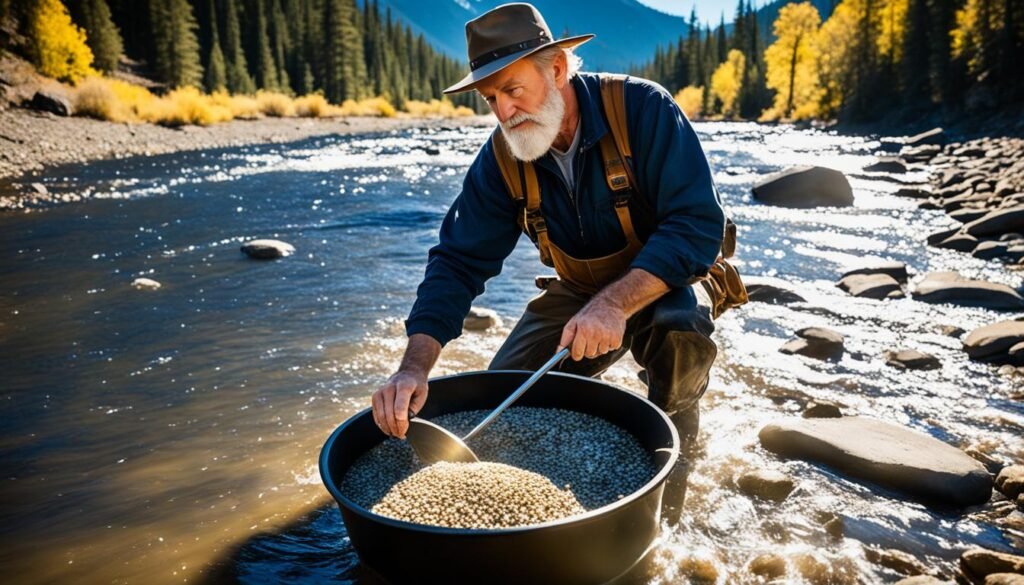Did you know that there are vast reserves of gold waiting to be discovered, just beneath our feet? It’s true!
Unexplored gold resources hold a hidden wealth that has the potential to transform economies and change lives. Gold, the precious metal that has captivated human fascination for centuries, continues to be a sought-after treasure today.
And with advanced exploration techniques and technological advancements, the possibility of uncovering these untapped riches is closer than ever.
Key Takeaways
- Unexplored gold resources hold immense potential for economic growth and prosperity.
- Modern technology and exploration methods are revolutionizing the search for hidden gold deposits.
- Gold mining has a significant impact on the environment, but sustainable practices can help minimize the damage.
- The discovery of new gold deposits can have far-reaching effects on economies, societies, and politics.
- The future of gold prospecting holds tremendous potential for uncovering hidden wealth and unearthing prosperity.
The Lure of Gold: Mankind’s Eternal Obsession
Gold has always fascinated mankind, playing a pivotal role in history and inspiring a continuous search for riches. Throughout the centuries, gold has been used as currency, a symbol of wealth and power, and a precious material for jewelry and decorative arts.
It has fueled exploration and colonization, sparked wars, and shaped economies. Today, gold fever continues to drive prospectors in their quest for fortune. The allure of gold, both its historical significance and its modern-day obsession, is a driving force behind the exploration of unexplored gold resources.
The Pivotal Role of Gold in History
Gold’s historical significance cannot be understated. Ancient civilizations revered gold for its rarity and beauty. It was used to create lavish jewelry, intricate artwork, and ornate monuments. Gold became a universal standard of wealth and trade, enabling economic systems to flourish.
From the Egyptians and the Greeks to the Aztecs and the Incas, gold held immense cultural and monetary value. It symbolized power, status, and prestige. Throughout history, conquistadors, explorers, and adventurers risked their lives in search of gold, driven by a desire for riches and the promise of a better life.
Modern-Day Gold Fever: A Continual Search
The allure of gold continues to captivate people around the world. Despite the advancements of modern society, mankind’s obsession with gold persists. Today, gold remains a sought-after commodity, valued for its stability and as a hedge against inflation. Gold mining companies and individual prospectors tirelessly scour the globe for new discoveries, hoping to strike it rich.
The allure of finding untouched gold reserves and the potential for substantial profits fuel the modern-day gold fever. The search for gold has become a thrilling adventure, blending history, geology, and the adrenaline rush of prospecting.
Unexplored Gold Resources: What Lies Beneath

Beneath the surface lies a vast expanse of unexplored gold resources, holding untapped wealth and mining potential. These unexplored areas are waiting to be discovered and developed, offering opportunities for economic growth and prosperity.
Exploration methods, such as geophysical surveys and geological mapping, are crucial in identifying areas with high gold potential. With advanced technology and the right strategies, the hidden wealth of unexplored gold resources can be uncovered.
Geophysical surveys play an integral role in identifying areas with potential gold deposits. By analyzing variations in underground electromagnetic fields or magnetic properties, prospectors can pinpoint areas where gold may be present. Similarly, geological mapping helps to understand the geological history of a region and identify favorable structures and formations that are indicative of gold-bearing sites.
With the advancement of technology, prospectors now have access to sophisticated tools and techniques that aid in the discovery of unexplored gold resources. High-resolution satellite imagery, drone technology, and ground-penetrating radar systems provide valuable data and enhance the efficiency of prospecting efforts.
By combining these modern exploration methods with geological knowledge and expertise, prospectors have the potential to unlock the hidden wealth of unexplored gold resources. The development of these resources can contribute to local economies, create job opportunities, and drive sustainable growth, benefiting both the mining industry and the communities in which they operate.
| Exploration Methods | Advantages |
|---|---|
| Geophysical Surveys | Identify areas with high gold potential |
| Geological Mapping | Understand the geological history and identify favorable structures |
| High-resolution Satellite Imagery | Provide detailed aerial views of potential gold-bearing sites |
| Drone Technology | Collect data in remote or inaccessible areas |
| Ground-penetrating Radar Systems | Detect underground features and help locate gold deposits |
Prospecting Adventures: Tales of Lost Mines
The search for gold has led to countless adventures and tales of lost mines. These thrilling stories fuel the imaginations of modern-day prospectors and inspire them to embark on their own quests in search of hidden riches. Two legendary tales of lost mines have captured the attention of treasure hunters and sparked intrigue for generations: Slumach’s lost gold mine and Jesse James’s buried treasure.
The Legend of Slumach’s Lost Gold Mine
Slumach’s lost gold mine is a famous legend in British Columbia, Canada. The story revolves around a man named Slumach, a Sto:lo First Nations member who was accused of killing a man. Before his execution, Slumach claimed to know the location of a valuable gold mine worth billions. However, he never revealed the mine’s whereabouts, taking its secret to the grave.
The legend of Slumach’s lost gold mine has captivated adventurers and treasure hunters for over a century. Many have tried to unravel the mystery and locate the elusive mine, but all attempts have been in vain. The allure of the hidden treasure remains strong, enticing prospectors to explore the rugged wilderness of British Columbia in search of the fabled gold mine.
The Mystery of Jesse James’s Buried Treasure
Jesse James, the notorious American outlaw, is known for his daring robberies and legendary status. According to legend, Jesse James amassed a significant fortune from his criminal activities. Before his death, it is rumored that he hid his ill-gotten gains in a secret location, leaving behind a buried treasure that has yet to be found.
The mystery of Jesse James’s buried treasure has attracted treasure hunters from across the United States. The exact location of the hidden wealth remains a closely guarded secret, fueling speculation and inspiring countless adventurers to embark on treasure-hunting expeditions.
The allure of discovering Jesse James’s buried treasure continues to captivate the imagination of modern-day prospectors, offering the promise of untold riches and a connection to history’s most infamous outlaw.

Panning for Profit: Modern Methods in Gold Prospecting
Panning for gold has long been an iconic and effective method in the world of gold prospecting. While the basic technique remains unchanged, modern prospectors now have access to advanced methods and equipment that greatly enhance their chances of finding profitable deposits.
These innovative tools have revolutionized the efficiency and profitability of the search for gold, allowing prospectors to extract precious metal from streams, rivers, and other gold-bearing areas with greater ease.
One of the essential modern tools used in gold prospecting is the metal detector. These devices use electromagnetic fields to detect metallic objects, including nuggets and flakes of gold. By sweeping the detector over the ground, prospectors can identify areas where gold may be present, helping them target their panning efforts more effectively.

Another popular method in modern gold prospecting is the use of highbankers, which are powered sluice boxes equipped with a water pump. Highbankers allow prospectors to process larger quantities of material in a shorter time, increasing the chances of finding profitable deposits. By combining the benefits of a sluice box and a power sluice, highbankers effectively separate gold from other heavy metals and materials, maximizing the potential for profit.
Sluice boxes, another essential tool, have also evolved in recent years. These long, narrow boxes are equipped with riffles, mats, and carpets that capture and retain gold as water flows through them. The modern designs of sluice boxes, such as the use of different materials and adjustable angles, enable prospectors to optimize gold recovery and minimize the loss of fine particles.
Dredges are another advanced method used in modern gold prospecting. These powerful machines are capable of excavating and processing large volumes of material from rivers and streams. By sucking up gravel and sediment, dredges efficiently separate gold from other materials. Additionally, some dredges are equipped with sluice boxes and classifiers, further enhancing gold recovery and increasing the potential for profit.
With these modern methods and tools, gold prospectors have the ability to increase their productivity and maximize their chances of finding profitable gold deposits. Whether it’s using a metal detector to locate potential hotspots, employing a highbanker to process larger quantities of material, or utilizing a dredge to extract gold from riverbeds, modern-day prospectors are equipped with the knowledge and equipment necessary to make their gold panning endeavors more profitable than ever before.
Revolutionizing Gold Discovery: Technological Advances
Technological advances have revolutionized the process of discovering and mining gold. With the help of innovative tools and techniques, prospectors now have greater efficiency, accuracy, and safety in their quest for gold.
Geographical Information Systems (GIS) in Prospecting
Geographical Information Systems (GIS) have emerged as indispensable tools for gold prospecting. These advanced systems allow prospectors to map and analyze data, providing valuable insights into potential gold deposits. GIS technology integrates topographical data, geological structures, and historical mining activity, enabling prospectors to pinpoint areas with the highest likelihood of success.

Advanced Mining Tools and Their Impact
Advanced mining tools have played a crucial role in transforming the gold mining industry. The use of drones, remote sensing devices, and robotic equipment has significantly enhanced the efficiency and safety of gold exploration and extraction.
Drones provide aerial surveys, capturing high-resolution images and detailed 3D maps of prospective sites. Remote sensing devices enable prospectors to gather remote data on geological formations and identify potential gold-bearing areas. Robotic equipment streamlines mining operations, increasing productivity while reducing the risk to human miners.
These technological advances in gold discovery have not only improved the accuracy and effectiveness of prospecting but have also reduced the environmental impact of mining. With the help of GIS and advanced mining tools, prospectors can navigate uncharted territories, uncovering hidden gold resources and paving the way for a prosperous future in the gold mining industry.
The Environmental Impact of Gold Mining
Gold mining has a significant environmental impact, resulting in deforestation, water pollution, and habitat destruction. However, the industry is making efforts to minimize these negative effects through sustainable mining practices. By prioritizing responsible land management, water conservation, and the use of eco-friendly technologies, gold mining can strike a balance between economic prosperity and protecting the natural environment.
Minimizing Environmental Damage in Gold Exploration
In order to minimize environmental damage, gold exploration companies are implementing various strategies and technologies. These include:
- Reclamation and restoration of mined areas to mitigate the loss of biodiversity and promote ecosystem recovery.
- Water management practices, such as the recycling and treatment of mine wastewater, to reduce water pollution and preserve water resources.
- Implementation of efficient waste management systems to minimize the release of harmful substances into the environment.
- Adopting best practices for reducing greenhouse gas emissions and minimizing the carbon footprint of mining operations.
These measures are crucial in mitigating the environmental impact of gold mining and ensuring the long-term sustainability of the industry.
The Importance of Sustainable Mining Practices
Sustainable mining practices are essential for the preservation of ecosystems, the protection of wildlife habitats, and the promotion of local communities’ well-being. By embracing sustainable practices, gold mining companies can:
- Minimize the disturbance to sensitive ecosystems and reduce the loss of biodiversity caused by mining activities.
- Support the development of local economies by creating job opportunities and fostering community engagement.
- Establish partnerships with local communities and indigenous peoples to ensure their rights are respected and their voices are heard throughout the mining process.
- Invest in research and innovation to develop cleaner and more efficient mining technologies that minimize environmental impacts.
By integrating sustainable mining practices into their operations, gold mining companies can contribute to a more environmentally responsible and socially beneficial industry.
American Gold Rushes: Then and Now
The United States has a rich history of gold rushes that shaped the nation and attracted thousands of fortune seekers. From the iconic California Gold Rush of 1849 to the Klondike Gold Rush in Alaska and the Yukon at the turn of the 20th century, these historical gold rushes left a lasting impact on American society and the economy.
Today, modern-day prospectors continue to explore the country’s unexplored gold resources, following in the footsteps of those who came before them. With advancements in technology and improved prospecting techniques, the search for gold has become more precise and efficient. Yet, the thrill and allure of striking it rich still captivate the hearts and minds of prospectors.
While the days of large-scale gold rushes may be over, the spirit of adventure and the quest for wealth continue to drive modern-day prospecting. Today’s prospectors use a combination of traditional and innovative methods to search for hidden gold deposits.
Exploration techniques such as geological mapping, geophysical surveys, and advanced mining tools enable prospectors to identify high-potential areas and maximize their chances of success. The use of technology, from metal detectors to drones, has revolutionized the efficiency and profitability of modern-day prospecting.
Whether it’s panning in rivers, analyzing geological data, or exploring unexplored territories, prospectors harness their knowledge, experience, and determination in the quest for hidden treasure. The American gold rushes of the past may be part of history, but the legacy of those gold rushes lives on, fueling the dreams and ambitions of modern-day prospectors.
Discovering the Golden Path: Strategies for Finding Hidden Deposits
Successful gold prospecting requires a deep understanding of gold-bearing geology and the ability to interpret signs in the natural landscape. By comprehending the geological processes that concentrate gold deposits and reading the signs left behind, prospectors can significantly enhance their chances of discovering hidden deposits.
Understanding Gold-Bearing Geology
In order to successfully find hidden gold deposits, it is crucial to have a comprehensive understanding of gold-bearing geology. This involves studying the geological formations and processes that create environments favorable for gold mineralization.
By examining the rock types, mineral associations, and geological structures in a given area, prospectors can identify areas with a higher likelihood of containing gold deposits. Conducting research, studying geological maps, and consulting with geologists can provide valuable insights into the gold-bearing potential of a specific location.
Reading the Signs: How to Know Where to Look
Another important aspect of finding hidden gold deposits is the ability to read the signs that indicate the presence of gold. These signs can be both subtle and overt, and they vary depending on the geological characteristics of the area.
Prospecting techniques such as observing the presence of certain minerals associated with gold, examining alteration zones, or identifying specific rock formations can reveal valuable information about potential gold deposits.
Moreover, prospectors need to pay attention to natural indicators like changes in soil color, the presence of quartz veins, or the occurrence of placer deposits. By honing their observation skills and actively looking for these signs, prospectors can narrow down their search and focus on areas with the highest potential for gold discovery.
The Psychology Behind Gold Hunting
Gold hunting goes beyond the search for riches—it taps into the psychology of human nature and our innate desire for adventure, excitement, and the thrill of the chase. The pursuit of gold fuels our sense of exploration and discovery, offering a chance to escape the ordinary and embark on a quest for the extraordinary. For many, gold prospecting also serves as a form of meditation, providing a sense of peace, focus, and connection with nature.
Legal Aspects and Rights of Gold Prospecting
When it comes to gold prospecting, navigating the legal landscape is crucial to ensure compliance with regulations and protect your rights. Understanding the legal aspects of gold prospecting is essential for both individual prospectors and mining companies to operate legally and responsibly.
One of the key considerations in gold prospecting is acquiring the necessary permits. These permits grant you the right to explore and extract gold from specific areas. The requirements for obtaining permits may vary depending on the jurisdiction and the type of mining activity. It is important to research and understand the permitting process in your location to ensure you are in full compliance with the law.
In addition to permits, understanding land rights is essential for gold prospecting. Mining activities often take place on both public and private lands, and it is important to know the legal boundaries and restrictions associated with each. Some lands may be off-limits for mining due to environmental preservation or cultural significance, so it is crucial to respect these restrictions and obtain the necessary permissions before conducting any prospecting activities.
Adhering to environmental regulations is another critical aspect of gold prospecting. Extracting gold can have an impact on the environment, such as habitat disruption or water pollution. It is important to follow environmental regulations and implement responsible mining practices to minimize negative effects on the ecosystem. This includes proper waste management, reclamation of disturbed areas, and using eco-friendly technologies wherever possible.
By understanding and abiding by the legal framework surrounding gold prospecting, you can ensure that your activities are conducted within the boundaries of the law. This not only protects your rights but also promotes responsible mining practices that balance economic prosperity with environmental sustainability.
| Key Considerations | Description |
|---|---|
| Permits | Understanding the permit acquisition process and complying with permit requirements. |
| Land Rights | Knowing the legal boundaries and restrictions associated with mining on public and private lands. |
| Environmental Regulations | Adhering to environmental laws and implementing responsible mining practices to minimize environmental impact. |
The Global Impact of Gold Discoveries
Gold discoveries have a profound influence on the world economy, as well as social and political landscapes. When new gold deposits are discovered, they have the potential to stimulate economic growth, create employment opportunities, and attract investment to mining regions.
The abundance of gold can lead to increased production and export, contributing to a nation’s overall prosperity. The extraction and processing of gold also require various services and infrastructure, such as transportation, machinery, and labor, which further contribute to economic activity.
Furthermore, gold discoveries can have significant social implications. The development of gold resources often leads to changes in demographics, with an influx of workers and their families into mining communities. These communities may experience population growth, the establishment of new schools, healthcare facilities, and an overall transformation of the local infrastructure. The presence of gold mines can shape the social fabric, culture, and traditions of these regions.
The political implications of gold finds are equally noteworthy. Governments have the responsibility to regulate and manage the mining industry, ensuring the fair distribution of wealth and protecting the environment. Gold discoveries can influence policies related to taxation, resource management, land rights, and labor laws. Moreover, gold mining can impact international relations, as nations seek to attract investments and negotiate trade agreements for the export and import of gold.
Overall, the global impact of gold discoveries extends beyond mere economic gains. They shape societies, economies, and politics, leaving a lasting legacy on the world stage.
Conclusion
As technology continues to advance and our understanding of gold deposits deepens, the future of gold prospecting holds great potential. With the vast expanse of unexplored gold resources and the use of innovative exploration techniques, the hidden wealth of gold can be unearthed, leading to economic prosperity and opportunities for those who embark on the pursuit.
Gold prospecting continues to captivate the human spirit, offering not only the promise of wealth but also adventure, discovery, and a deep connection with our natural surroundings. The allure of unexplored gold resources and the thrill of the chase will continue to drive modern-day prospectors to explore new territories, uncovering the potential of hidden gold deposits.
As we look to the future, it is clear that the journey to discover unexplored gold resources will play a crucial role in shaping economies, societies, and the environment. The potential for prosperity lies beneath the surface, waiting to be unearthed. Gold prospecting holds not only financial rewards but also the opportunity for personal growth, historical preservation, and sustainable development.
FAQ
What is the significance of gold throughout history?
Gold has been used as currency, a symbol of wealth and power, and a precious material for jewelry and decorative arts. It has fueled exploration, sparked wars, and shaped economies.
What are the opportunities offered by unexplored gold resources?
Unexplored gold resources hold untapped wealth and mining potential, offering opportunities for economic growth and prosperity.
What are some famous tales of lost mines?
Slumach’s lost gold mine and Jesse James’s buried treasure are two intriguing legends that have eluded explorers for centuries.
What modern methods are used in gold prospecting?
Modern prospectors have access to advanced techniques and equipment, including metal detectors, highbankers, sluice boxes, and dredges.
How have technological advances revolutionized gold discovery?
Geographical Information Systems (GIS) help map and analyze data, while advanced mining tools such as drones and remote sensing enhance efficiency and safety in gold exploration.
What are the environmental impacts of gold mining?
Gold mining can have significant environmental impacts, including deforestation, water pollution, and habitat destruction. Sustainable mining practices are being implemented to minimize these negative effects.
What are some notable American gold rushes?
The California Gold Rush of 1849 and the Klondike Gold Rush in Alaska and the Yukon are among the historical gold rushes that left a lasting impact on American society and the economy.
What strategies can increase the chances of finding hidden gold deposits?
Understanding gold-bearing geology and recognizing indicators in the natural landscape are key strategies in gold prospecting.
What is the psychology behind gold hunting?
Gold hunting taps into the psychology of adventure, excitement, and the thrill of the chase. It can also serve as a form of meditation and provide a deep connection with nature.
What legal aspects should gold prospectors consider?
Gold prospectors should be aware of permit acquisition, land rights, and the responsibility to adhere to environmental regulations.
What are the global impacts of gold discoveries?
Gold discoveries can stimulate economic growth, create jobs, and have social and political implications in terms of wealth distribution, government policies, and international relations.
What is the future of gold prospecting?
With technological advancements and a vast expanse of unexplored gold resources, the future of gold prospecting holds great potential for economic prosperity and opportunities.
Source Links
- https://www.popularmechanics.com/adventure/outdoors/a42953312/jesse-jamess-lost-gold/
- https://www.cbc.ca/radio/docproject/is-a-secret-gold-mine-hidden-in-the-b-c-mountains-this-treasure-hunter-says-so-1.5306383
- https://www.everand.com/book/290213165/The-Secret-History-of-Gold-Prospecting-in-the-United-States-and-the-38-States-Where-Gold-Has-Already-Been-Found








